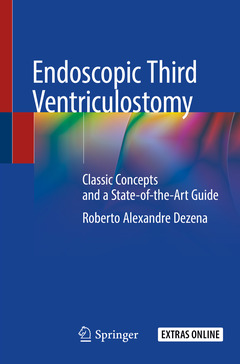Description
Endoscopic Third Ventriculostomy, 1st ed. 2020
Classic Concepts and a State-of-the-Art Guide
Author: Dezena Roberto Alexandre
Language: English
Subject for Endoscopic Third Ventriculostomy:
Approximative price 52.74 €
In Print (Delivery period: 15 days).
Add to cartPublication date: 10-2020
111 p. · 15.5x23.5 cm · Paperback
Approximative price 52.74 €
In Print (Delivery period: 15 days).
Add to cartPublication date: 10-2019
Support: Print on demand
Description
/li>Contents
/li>Biography
/li>Comment
/li>
Endoscopic third ventriculostomy is the most widely performed neuroendoscopic procedure around the world. Several scientific papers appear in the scientific literature every month, with an increasing number, given the great interest neuroendoscopy has aroused as well as controversies about certain aspects of endoscopic third ventriculostomy. With this reasoning, the goal of this book is to be a reference in the revision of classic concepts and scientifically proven aspects about the indications and techniques of endoscopic third ventriculostomy, as well as new neuroendoscopic tendencies.
The book is structured in 2 parts and into 7 chapters. Part I ? Classic Concepts ? comprises the first 2 chapters, covering general aspects of neuroendoscopy such as historical notes, endoscopic anatomy and ventricular system physiology. Part II ? State-of-the-Art ? comprises chapters 3 to 7. From chapters 3 to 6 the book will discuss general principles of endoscopic ventricular technique and the applications of endoscopic third ventriculostomy in different age groups, and its association to choroid plexus coagulation. Chapter 7 deals with alternative ways of communicating the ventricular system with the cisterns of the subarachnoid space. All chapters are richly illustrated with high resolution images; there are links to online access to demonstrative surgical videos.
Designed for neurosurgeons at every level, the book will be unique in the market, as there is no similar book in the current scientific literature that specifically discusses endoscopic third ventriculostomy in its broadest sense.
Part I Classic Concepts
Chapter 1. Historical Aspects of Hydrocephalus and its Treatments
1.1 Development of the Concept of Hydrocephalus
1.1.1 Anatomical and Physiological Bases
1.1.2 Attempts of Treatment
1.2 Treatment of Hydrocephalus Based on the Third Ventricle
1.2.1 Third-Fourth Interventriculostomy
1.2.2 Third Ventriculostomy through Craniotomy
1.2.3 Stereotactic Third Ventriculostomy
1.2.4 Percutaneous Third Ventriculostomy
1.3 Development of Endoscopic Third Ventriculostomy (ETV)
1.3.1 Pioneers of Neuroendoscopy
1.3.2 Mixter: Summary Biography and the First ETV
1.3.3 Later Years
Chapter 2. Anatomy and Physiology of the Ventricular System
2.1 Anatomy
2.1.1 Historical Milestones of the Ventricular Anatomy
2.1.2 Basic Ventricular Anatomy
2.2 Physiology of Cerebrospinal Fluid (CSF) Circulation
Part II State-of-the-Art
Chapter 3: Endoscopic Ventricular Anatomy
3.1 General Aspects3.2 Lateral Ventricles
3.3 Third Ventricle
3.3.1 Anterior Segment
3.3.2 Middle Segment
3.3.3 Posterior Segment
Chapter 4: Basic Principles of Endoscopic Neurosurgery
4.1 General Concepts4.2 Basic Techniques
Chapter 5: General Principles of Endoscopic Third Ventriculostomy (ETV)
5.1 General Aspects
5.2 ETV Success Score
5.3 Role of Patient´s Age and Etiology of Hydrocephalus
5.4 ETV and Choroid Plexus Coagulation
Chapter 6: Surgical Technique of Endoscopic Third Ventriculostomy (ETV)
6.1 Opening Tuber Cinereum
6.2 Membrane of Liliequist (ML)
Chapter 7: Alternative Technique: Endoscopic Transseptumpellucidumrostrostomy (ETSPR)
7.1 Introduction
7.2 Methodology7.2.1 Anatomical Landmarks of Frontal Horn and Longitudinal Fissure
7.2.2 Endoscopic Fenestration from Lateral Ventricle
7.2.3 Statistical Analysis
7.3 Results7.3.1 Measurements of Anatomical Landmarks of Frontal Horn and Longitudinal Fissure
7.3.2 Endoscopic Fenestration from Lateral Ventricle
7.4 Discussion
7.4.1 Floor of Frontal Horn and Hypothalamic-Septal Triangle
7.4.2 Functional Considerations of Septal Area
7.4.3 Technical Feasibility of Endoscopic Fenestration
7.5 Conclusions
Roberto Alexandre Dezena, M.D., Ph.D.
Associate Professor and Chief
Neurosurgery Residency Program Director
Division of Neurosurgery
Neurological System Unit
Clinics Hospital
Federal University of Triângulo Mineiro
Uberaba, Minas Gerais, Brazil
MD from Federal University of Triângulo Mineiro, Uberaba, Brazil (2003), medical residency in Neurosurgery at Santa Casa de Misericórdia de Ribeirão Preto, Brazil (2009), Ph.D. in Neurosurgery at Ribeirão Preto Medical School of University of São Paulo, Brazil (2011), and Postdoctoral Fellowship at Federal University of Triângulo Mineiro, Uberaba, Brazil (2014). Fellow of Eberhard-Karls Universität Tübingen, Germany, Hiroshima University, Japan, and Saint Louis University, USA. In Brazil, he is Full Member of Brazilian Society of Neurosurgery (SBN) and Brazilian Academy of Neurosurgery (ABNc), besides vice president of Minas Gerais Neurosurgery Society and member of deliberative counsil of Brazilian Academy of Neurosurgery. Internationally, he is Fellow of World Federation of Neurosurgical Societes (WFNS), Active Member of International Federation of Neuroendoscopy (IFNE), Active Member of International Society for Pediatric Neurosurgery (ISPN), Active Member of Walter E. Dandy Neurosurgical Society (WEDNS), and Full Member of both Latin American Federation of Neurosurgery Societes (FLANC) and Latin American Group of Studies in Neuroendoscopy (GLEN). Currently is Associate Professor and Chief of Division of Neurosurgery, Clinics Hospital, Federal University of Triângulo Mineiro, and Professor of Postgraduate Program in Health Sciences and Postgraduate Program in Applied Biosciences, both at Federal University of Triângulo Mineiro, Uberaba, Brazil. Director of the Reference Center for Continuing Education of Latin American Federation of Neurosurgery Societes (FLANC), at the same university. Neurosurgical activities in Microneurosurgery (vascular and
Unique title in the field
Comprehensive review
A large number of high resolution images
These books may interest you

Endoscopic Neurological Surgery 125.23 €



